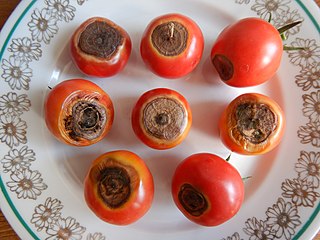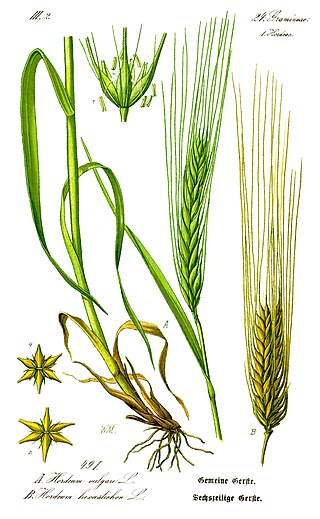Related Research Articles

Wheat is a grass widely cultivated for its seed, a cereal grain that is a worldwide staple food. The many species of wheat together make up the genus Triticum ; the most widely grown is common wheat. The archaeological record suggests that wheat was first cultivated in the regions of the Fertile Crescent around 9600 BCE. Botanically, the wheat kernel is a type of fruit called a caryopsis.

The pathogenic fungus Cryphonectria parasitica is a member of the Ascomycota. This necrotrophic fungus is native to East Asia and South East Asia and was introduced into Europe and North America in the early 1900s. The fungus spread rapidly and caused significant tree loss in both regions.
Blight refers to a specific symptom affecting plants in response to infection by a pathogenic organism.
The cereal grain wheat is subject to numerous wheat diseases, including bacterial, viral and fungal diseases, as well as parasitic infestations.

Alternaria is a genus of Deuteromycetes fungi. All species are known as major plant pathogens. They are also common allergens in humans, growing indoors and causing hay fever or hypersensitivity reactions that sometimes lead to asthma. They are present in the human mycobiome and readily cause opportunistic infections in immunocompromised people such as AIDS patients.

The fungus Cochliobolus sativus is the teleomorph of Bipolaris sorokiniana (anamorph) which is the causal agent of a wide variety of cereal diseases. The pathogen can infect and cause disease on roots, leaf and stem, and head tissue. C. sativus is extremely rare in nature and thus it is the asexual or anamorphic stage which causes infections. The two most common diseases caused by B. sorokiniana are spot blotch and common root rot, mainly on wheat and barley crops.

Damping off is a horticultural disease or condition, caused by several different pathogens that kill or weaken seeds or seedlings before or after they germinate. It is most prevalent in wet and cool conditions.
Alternaria triticina is a fungal plant pathogen that causes leaf blight on wheat. A. triticina is responsible for the largest leaf blight issue in wheat and also causes disease in other major cereal grain crops. It was first identified in India in 1962 and still causes significant yield loss to wheat crops on the Indian subcontinent. The disease is caused by a fungal pathogen and causes necrotic leaf lesions and in severe cases shriveling of the leaves.
Hapalosphaeria deformans is an ascomycete fungus. It is the causal organism of Stamen Blight of caneberry. It is a common disease in Pacific Northwest of North America, elsewhere in Canada, Denmark, Germany, Great Britain, Ireland, and Spain. It affects the commercial harvest of Oregon dewberries, and boysenberries and cascadeberries in British Columbia. It is not commercially significant in red raspberry in Scotland.

Sclerotinia sclerotiorum is a plant pathogenic fungus and can cause a disease called white mold if conditions are conducive. S. sclerotiorum can also be known as cottony rot, watery soft rot, stem rot, drop, crown rot and blossom blight. A key characteristic of this pathogen is its ability to produce black resting structures known as sclerotia and white fuzzy growths of mycelium on the plant it infects. These sclerotia give rise to a fruiting body in the spring that produces spores in a sac which is why fungi in this class are called sac fungi (Ascomycota). This pathogen can occur on many continents and has a wide host range of plants. When S. sclerotiorum is onset in the field by favorable environmental conditions, losses can be great and control measures should be considered.

Ascochyta is a genus of ascomycete fungi, containing several species that are pathogenic to plants, particularly cereal crops. The taxonomy of this genus is still incomplete. The genus was first described in 1830 by Marie-Anne Libert, who regarded the spores as minute asci and the cell contents as spherical spores. Numerous revisions to the members of the genus and its description were made for the next several years. Species that are plant pathogenic on cereals include, A. hordei, A. graminea, A. sorghi, A. tritici. Symptoms are usually elliptical spots that are initially chlorotic and later become a necrotic brown. Management includes fungicide applications and sanitation of diseased plant tissue debris.
Alternaria dauci is a plant pathogen. The English name of the disease it incites is "carrot leaf blight".

Alternaria solani is a fungal pathogen that produces a disease in tomato and potato plants called early blight. The pathogen produces distinctive "bullseye" patterned leaf spots and can also cause stem lesions and fruit rot on tomato and tuber blight on potato. Despite the name "early," foliar symptoms usually occur on older leaves. If uncontrolled, early blight can cause significant yield reductions. Primary methods of controlling this disease include preventing long periods of wetness on leaf surfaces and applying fungicides. Early blight can also be caused by Alternaria tomatophila, which is more virulent on stems and leaves of tomato plants than Alternaria solani.
Naohidemyces vaccinii is a plant pathogen that affects members of the Vaccinium and Tsuga genera, causing leaf rust on lingonberries, blueberries, and cranberries, and early needle cast on hemlocks. Naohidemyces vaccinii is found on the Vaccinium genus in Canada, the United States, the United Kingdom, Europe, Russia, China, Korea, and Japan, and on hemlock in AK, ID, WA in the United States, BC in Canada, and Japan.
Alternaria dianthi, sometimes known as carnation blight, is a fungal pathogen of the genus Dianthus. Alternaria dianthi infections begin as small circular or ovular spots on leaves and stems, which can be red, purple, brown, yellow or gray.

Plant disease forecasting is a management system used to predict the occurrence or change in severity of plant diseases. At the field scale, these systems are used by growers to make economic decisions about disease treatments for control. Often the systems ask the grower a series of questions about the susceptibility of the host crop, and incorporate current and forecast weather conditions to make a recommendation. Typically a recommendation is made about whether disease treatment is necessary or not. Usually treatment is a pesticide application.

Barley, a member of the grass family, is a major cereal grain grown in temperate climates globally. It was one of the first cultivated grains, particularly in Eurasia as early as 10,000 years ago. Globally 70% of barley production is used as animal fodder, while 30% as a source of fermentable material for beer and certain distilled beverages, and as a component of various foods. It is used in soups and stews, and in barley bread of various cultures. Barley grains are commonly made into malt in a traditional and ancient method of preparation.
This article summarizes different crops, what common fungal problems they have, and how fungicide should be used in order to mitigate damage and crop loss. This page also covers how specific fungal infections affect crops present in the United States.
Black point is often considered a fungal disease that affects wheat, barley and rye. It is thought to be caused by various species of Alternaria, Fusarium, and Helminthosporium, and possibly other fungal genera. The fungus forms after the seeds have set but while they are still green and it is potentiated by high humidity. Infected areas are brown to black in color, and as the disease spreads the kernels may become shriveled. Occasionally the infected areas have a reddish tinge.
Collar rot is a symptomatically described disease that is usually caused by any one of various fungal and oomycete plant pathogens. It is present where the pathogen causes a lesion localized at or about the collet between the stem and the root. The lesions develop around the stem eventually forming a "collar". Observationally, collar rot grades into "basal stem rot", and with some pathogens is the first phase of "basal stem rot" often followed by "root rot". Collar rot is most often observed in seedings grown in infected soil. The pathogens that cause collar rot may be species or genera specific. But generalist pathogens such as Athelia rolfsii are known to attack over 200 different species. While bacteria caused collar rot is not common, trees infected with Fire blight may develop collar rot. Non-parasitic collar rot may be caused by winter damage.
References
- ↑ Chalkley, D. (2010). "Invasive Fungi: Alternaria leaf blight of wheat - Alternaria triticina". Systematic Mycology and Microbiology Laboratory, Agricultural Research Service, United States Department of Agriculture (USDA ARS). Archived from the original on 29 October 2014.
{{cite journal}}: Cite journal requires|journal=(help) - ↑ Watkins, John E. "Black Point Disease of Wheat" (PDF). Institute of Agriculture and Natural Resources at the University of Nebraska–Lincoln. Archived (PDF) from the original on 25 October 2014.
- ↑ Zhang, Julia X.; Jin, Yue; Rudd, Jackie C. & Bockelman, Harold E. (2008). "New Fusarium Head Blight Resistant Spring Wheat Germplasm Identified in the USDA National Small Grains Collection" (PDF). Crop Science. 48: 223–235. doi:10.2135/cropsci2007.02.0116. Archived (PDF) from the original on 11 August 2014.
- 1 2 "Septoria Leaf Blotch, Stagonospora Glume Blotch" (PDF). Texas AgriLife Extension Service, Texas A&M University. 4 November 2008. Archived (PDF) from the original on 11 August 2014.
- 1 2 3 Wong, J.; et al. "Wheat Diseases and Pests: a guide for field identification". United States Department of Agriculture.
